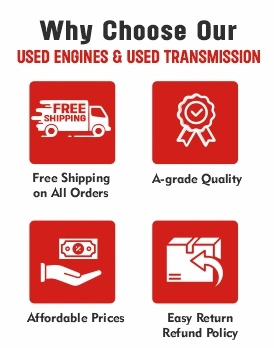Recent Blogs
- Common Mistakes to Avoid When Purchasing Used Automobile Engines
- Cheap Used Transmissions near me: Top Used Transmission Dealers to Check Out
- Top Tips for Buying Used Automobile Engines from a Salvage Yard near me
- Used Engine Dealers and Cheap Transmissions: How to Get Both Under $500
- How to Locate a Salvage Yard Near Me with Quality Used Transmissions for Sale?
- Used Transmission with Warranty: A Safer Choice for Your Car Repair
- How to Query Suppliers for a ‘Used Saab Engine’ Online Safely
- Mazda Rotary Engine for Sale: RX7 Wankel Rotary Engine
- Reliable Performance: https://usedenginepart.com/reliable-performance-2015-nissan-sentra-transmission/2015 Nissan Sentra Transmission
- Why a Used Scion tC Manual Transmission Could Be Your Best Upgrade

Used Engines for Sale
- ACURA Engine
- AUDI Engine
- BMW Engine
- BUICK Engine
- CADILLAC Engine
- CHEVROLET Engine
- CHRYSLER Engine
- DODGE Engine
- FIAT Engine
- FORD Engine
- GMC Engine
- HONDA Engine
- HUMMER Engine
- HYUNDAI Engine
- INFINITI Engine
- ISUZU Engine
- JAGUAR Engine
- JEEP Engine
- KIA Engine
- LANDROVER Engine
- LEXUS Engine
- LINCOLN Engine
- MAZDA Engine
- MERCEDES Engine
- MERCURY Engine
- MINI Engine
- MITSUBISHI Engine
- NISSAN Engine
- OLDSMOBILE Engine
- PONTIAC Engine
- PORSCHE Engine
- SAAB Engine
- SATURN Engine
- SCION Engine
- SUBARU Engine
- SUZUKI Engine
- TESLA Engine
- TOYOTA Engine
- VOLKSWAGEN Engine
- VOLVO Engine
Used Engines for Sale
View MoreCommon Mistakes to Avoid When Purchasing Used Automobile Engines
Shopping for used automobile engines can feel like walking through a minefield if the process isn’t familiar. The idea sounds simple at first to find an engine, verify it works, drop it into the car, and done. Then the reality kicks in. Wrong engine code, no warranty coverage, unknown mileage, hidden leaks, and compatibility mixups can cost you hundreds of dollars. The problem isn’t usually bad luck. The mistakes are almost always the same predictable ones, just repeated over and over: rushing the purchase, trusting a looks fine visual inspection, ignoring proof of the donor vehicle, and not checking the long list of small technical details that actually matter more than big ones. Here in this guide, we will discuss the most common pitfalls which get people burned when shopping for used automobile engines.
1. Buying Based on Price Alone
The first trap is that people assumes ‘cheap is good’ which is not true. Seeing the lowest number on the list feels like winning, until the hidden side surfaces. A cheap engine is usually cheap for a reason high mileage, unknown maintenance history, cracked head, blown gasket someone just sprayed clean, or pulled from a vehicle that sat in a scrapyard exposed to moisture.
The smarter way is to treat price as the last factor, not the first. Mileage + engine series + compression health + seller credibility matter more than the sticker number. The lowest price often turns into the most expensive buy once the repair bills start stacking.
2. Not Matching Engine Codes and Compatibility Details
A common mistake people assume that ‘same year, same model’ means guaranteed compatibility. Modern vehicles don’t work like that anymore. One trim can have three engine revisions, and one month difference in production can mean a different ECU signal or intake layout.
VIN matching helps. Engine code matching helps even more.
Two engines which look identical can still fail to communicate properly with the ECU because of a single sensor variation. And if the shop discovers the mismatch after installation, that means double labor costs.
You need to always verify:
- Engine code
- VIN split year
- Transmission pairing
- ECU + immobilizer compatibility
- Intake/exhaust layout differences
- Mounting pattern
Skipping this check is one of the most expensive mistakes in the whole process, you can make.
3. Not Asking for Results from a Compression Test or Leak-Down
You can’t see wear on the inside with a visual check. You can’t see the gaskets, rings, valves, or seals from the outside. Even if the engine looks clean, it could still have problems with blow-by or insufficient compression.
If the seller says there is “no way to test” the engine, it’s usually a sign that you should leave right away. Reputable sellers, like usedenginepart.com, test parts before taking them out. Some even have videos that show the donor car running. The good ones retain records of the compression tests or at least let the buyer bring a mechanic.
One of the main reasons engines fail a few months after being installed is that they don’t go through compression testing. Check to see if the engine you want to buy has been tested for compression.
4. Not checking the mileage
You should never say how many miles you’ve driven. You should write down the mileage on the donor car. There should be anything that proves the claimed mileage, like an odometer disclosure, salvage documents, or a VIN lookup. You should never buy an engine without proof of how many miles it has on it.
Be careful with dealers who say “around 80k miles” or “low mileage” without documentation. Real documentation means numbers that can be checked, not guesswork.
5. No Warranty or a Warranty That Doesn’t Work
Many people don’t understand how warranties work on used car engines. Some warranties look good at first, but the tiny print discloses that the coverage ends as soon as something goes wrong. Some just cover flaws and not labor. Some void themselves if an unlicensed retailer puts the part in. Some only cover the block and not the sensors, harnesses, or electronics.
The worst ones are start-up warranties, which only cover you until the crankshaft rotates once. After that, you’re on your own. A better warranty means that the vendor is more likely to believe in the engine.
- A real warranty should have the following:
- Coverage for at least 30 to 90 days
- Proof in writing, not just a promise
- Terms for returns and replacements
- Labor coverage if possible
- Failures not automatically blamed on “installer error”
6. Not remembering about accessories
Some engines only come as a long block. Some come with everything, including extras like the alternator, starter, fuel rail, harness, sensors, coils, manifolds, and more. People get burned when they think that the accessories in the listing would definitely work.
It’s usually safer for shops to use parts from the old engine again. A broken alternator bracket or a sensor connector that isn’t there can make the installation take days longer.
7. Not looking for metal shavings or oil sludge
A basic inspection is more than just shining a flashlight inside the valve cover. The actual tale comes out when you pull the drain plug and look for dirt. Sludge means bad maintenance. Metal flakes signify wear on the inside and a bearing failure that is likely to happen.
This process only takes two minutes, but it will save you four digits on repair fees later.
8. Not Checking the Cause of Death of the Donor Vehicle
People usually prefer engines from cars that have been rear-ended over engines from automobiles that have been hit in the front or that have overheating problems. If the car was destroyed by fire, flooding, or damage to the engine compartment, the risk is substantially higher.
If an engine that was pulled from a car that was wrecked from behind runs well, it usually suggests that the engine wasn’t the problem.
9. Not following installation instructions
A lot of individuals think that “fix it in and go” is all they need. In actuality, most engine swaps should come with:
- New gaskets
- New spark plugs
- New fluids
- Thermostat
- Check the water pump
- Timing parts if the car has a lot of miles on it
If you don’t do these “while it’s out” maintenance tasks, you’ll have to take it apart again later. If you put used automobile engines in with blocked cooling lines, old oil sludge, or poor seals from the last engine, it will fail early, even if it is in great condition.
10. Buying from Unknown or Non-Reputable Sellers
This is where most horror stories start. Marketplaces are full of backyard pullouts, no-testing salvage yards, and flippers who just yank motors and hope for the best. Some vanish once the sale is done. Some refuse returns. Some don’t even document VINs.
The seller matters as much as the engine itself. A reputable auto recycler, licensed dismantler, or engine supplier with a real return policy like usedenginepart.com is the safe lane.
Final Thoughts
From the above gist, we conclude that finding solid used automobile engines is easy and smart choice rather than going for a brand-new long block. You must know what to avoid and what to look for to get the perfect fit of engine for your vehicle. When mileage is verified, the engine code matches, the warranty is real, and internal condition checks out, a used engine can easily last years. The problems only show up when the early due diligence is skipped.




